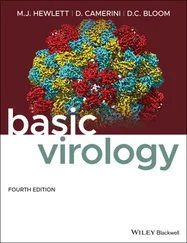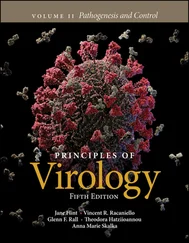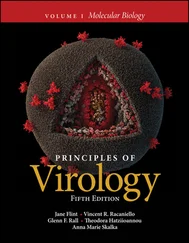Jane Flint - Principles of Virology
Здесь есть возможность читать онлайн «Jane Flint - Principles of Virology» — ознакомительный отрывок электронной книги совершенно бесплатно, а после прочтения отрывка купить полную версию. В некоторых случаях можно слушать аудио, скачать через торрент в формате fb2 и присутствует краткое содержание. Жанр: unrecognised, на английском языке. Описание произведения, (предисловие) а так же отзывы посетителей доступны на портале библиотеки ЛибКат.
- Название:Principles of Virology
- Автор:
- Жанр:
- Год:неизвестен
- ISBN:нет данных
- Рейтинг книги:3 / 5. Голосов: 1
-
Избранное:Добавить в избранное
- Отзывы:
-
Ваша оценка:
- 60
- 1
- 2
- 3
- 4
- 5
Principles of Virology: краткое содержание, описание и аннотация
Предлагаем к чтению аннотацию, описание, краткое содержание или предисловие (зависит от того, что написал сам автор книги «Principles of Virology»). Если вы не нашли необходимую информацию о книге — напишите в комментариях, мы постараемся отыскать её.
Volume I: Molecular Biology
Volume II: Pathogenesis and Control
Principles of Virology, Fifth Edition
Principles of Virology — читать онлайн ознакомительный отрывок
Ниже представлен текст книги, разбитый по страницам. Система сохранения места последней прочитанной страницы, позволяет с удобством читать онлайн бесплатно книгу «Principles of Virology», без необходимости каждый раз заново искать на чём Вы остановились. Поставьте закладку, и сможете в любой момент перейти на страницу, на которой закончили чтение.
Интервал:
Закладка:
Liu J, Yu C, Gui JF, Pang DW, Zhang QY.2018. Real-time dissecting the entry and intracellular dynamics of single reovirus particle. Front Microbiol 9:2797.
This paper uses microscopy techniques to track the entry of individual reovirus particles into cells.
Wec AZ, Nyakatura EK, Herbert AS, Howell KA, Holtsberg FW, Bakken RR, Mittler E, Christin JR, Shulenin S, Jangra RK, Bharrhan S,Kuehne AI, Bornholdt ZA, Flyak AI, Saphire EO, Crowe JE Jr, Aman MJ, Lai JR, Chandran K.2016. A “Trojan horse” bispecific-antibody strategy for broad protection against ebolaviruses. Science 354:350–354.
This study relies on the unique understanding of Ebolavirus entry to generate novel antibodies that inhibit entry by being delivered to the appropriate subcellular compartment.
STUDY QUESTIONS
1 You are studying a new DNA virus. You have two cell lines: cell line α expresses the receptor (permissive) but is not susceptible (multiple blocks to the viral reproduction cycle) and cell line β is not permissive but is susceptible. Which of the following statements are correct and why?Transfection of the virus DNA into α will lead to production of infectious particles.Transfection of virus DNA into β will produce infectious particles.Inhibiting production of the receptor in α will allow virus reproduction.Production of the virus receptor in β will allow virus reproduction.
2 You are working on a rhabdovirus that is cytopathic in dog cells but not rodent cells. What strategy would you use to identify the receptor in each cell line?
3 The S (spike) glycoprotein of coronaviruses can engage receptors by the N-terminal domain, the C-terminal domain, or both. The C-terminal domains of both human SARS coronaviruses bind ACE2 (angiotensin-converting enzyme 2) whereas that of MERS-CoV binds DDP4 (dipeptidyl peptidase 4). In contrast, in mouse hepatitis coronavirus (MHV) the N-terminal domain of S binds CEACAM (cell adhesion molecule 1). You have identified a novel coronavirus with an S protein that displays similarity to MHV at the N terminus and to SARS at the C terminus. What are the molecules most likely to function as receptors and how will you test this?
4 Viral fusion proteins mediate fusion between the viral and cellular membranes. This process begins with the insertion of fusion peptides or loops into the target cellular membrane; however, this step alone is not sufficient to complete the fusion process. Describe how additional conformational changes drive fusion.
5 Which of the following statements is correct?Non-enveloped virus entry does not depend on binding to a receptor.For enveloped viruses with multiple envelope proteins on their surface, all envelope proteins engage cell surface receptors.Viral fusion proteins on the surface of enveloped viruses cannot engage a receptor.Fusion of enveloped viruses can occur at the plasma membrane or at compartments of the endosomal pathway.
6 What experiments would you perform to determine whether endosome acidification is required for entry by a particular virus?
7 You produce a viral fusion protein in cells and cocultivate them with cells expressing the receptor. Would you observe cell-to-cell fusion? If you don’t observe this result, what are the possible explanations?
8 Describe the ways in which viral and subviral particles can be transported inside the cell.
9 What are the potential disadvantages for a virion reaching the lysosome?
10 Which of the following pathways would achieve delivery of the viral genome to the nucleus?Delivery of the viral genome to the cytoplasmic side of the nuclear poreHaving a capsid smaller than 39 nmDocking of a partially uncoated capsid to the nuclear pore that does not result in further uncoating or transport through the poreInteraction of the capsid with components of the nuclear pore that leads to subsequent transport and uncoating in the nucleus
11 For retroviruses that rely on cell division to access the host chromatin, how does the viral genome remain in the nucleus once cell division is completed?
6 Synthesis of RNA from RNA Templates

Introduction
The Nature of the RNA TemplateSecondary Structures in Viral RNA Naked or Nucleocapsid RNA
The RNA Synthesis MachineryIdentification of RNA-Dependent RNA Polymerases Three-Dimensional Structures of RNA-Dependent RNA Polymerases
Mechanisms of RNA SynthesisInitiation Capping Elongation Functions of Additional Polymerase Domains RNA Polymerase Oligomerization Template Specificity Unwinding the RNA Template Role of Cellular Proteins
Paradigms for Viral RNA Synthesis (+) Strand RNA Synthesis of Nested Subgenomic mRNAs (−) Strand RNA Ambisense RNA Double-Stranded RNA Unique Mechanisms of mRNA and Genome Synthesis of Hepatitis Delta Virus Do Ribosomes and RNA Polymerases Collide?
Origins of Diversity in RNA Virus GenomesMisincorporation of Nucleotides Segment Reassortment and RNA Recombination RNA Editing
Perspectives
References
Study Questions
LINKS FOR CHAPTER 6
Video: Interview with Dr. Karla Kirkegaard http://bit.ly/Virology_Kirkegaard
A swinging gate http://bit.ly/Virology_Twiv330
When a thing has been said and said well, have no scruple. Take it and copy it.
ANATOLE FRANCE
Introduction
The genomes of RNA viruses may be unimolecular or segmented; single stranded of (+), (−), or ambisense polarity; double stranded; or circular. These structurally diverse viral RNA genomes share a common requirement: they must be copied efficiently within the infected cell to provide both genomes for assembly into progeny virus particles andmessenger RNAs (mRNAs) for the synthesis of viral proteins. The production of these RNA molecules is a unique process that has no parallel in the cell. The genomes of all RNA viruses except retroviruses and hepatitis delta virus encode an RNA-dependent RNA polymerase(RdRP) ( Box 6.1) to catalyze the synthesis of new genomes and mRNAs.
Virus particles that contain (−) strand or double-stranded RNA genomes must contain the RdRP, because the incoming viral RNA can be neither translated nor copied by the cellular machinery. Consequently, the deproteinized genomes of (−) strand and double-stranded RNA viruses are not infectious. In contrast, viral particles containing a (+) strand RNA genome lack a viral polymerase; the deproteinized RNAs of these viruses areinfectious because they are translated in cells to produce, among other viral proteins, the viral RNA polymerase. An exception is the retrovirus particle, which contains a (+) stranded RNA genome that is not translated but rather copied to DNA by reverse transcriptase ( Chapter 10).
The mechanisms by which viral mRNA is made and the RNA genome is replicated in cells infected by RNA viruses appear even more diverse than the structure and organization of viral RNA genomes ( Fig. 6.1). Nevertheless, each mechanism of viral RNA synthesis meets two essential requirements common to all infectious cycles: (i) during replication, the RNA genome must be copied from one end to the other with no loss of nucleotide sequence; and (ii) viral mRNAs that can be translated efficiently by the cellular protein synthetic machinery must be made.
In this chapter, we consider the mechanisms of viral RNA synthesis, the switch from mRNA production to genome replication, and the origins of genetic diversity. Much of our understanding of viral RNA synthesis comes from experiments with purified components. Because it is possible that events proceed differently in infected cells, the results of such in vitro studies are used to build models for the different steps in RNA synthesis, which must then be tested in vivo . While many models exist for each reaction, those presented in this chapter were selected because they are consistent with experimental results obtained in different laboratories or have been validated with simplified systems in cells in culture. The general principles of RNA synthesis deduced from such studies are illustrated with a few viruses as examples.
Читать дальшеИнтервал:
Закладка:
Похожие книги на «Principles of Virology»
Представляем Вашему вниманию похожие книги на «Principles of Virology» списком для выбора. Мы отобрали схожую по названию и смыслу литературу в надежде предоставить читателям больше вариантов отыскать новые, интересные, ещё непрочитанные произведения.
Обсуждение, отзывы о книге «Principles of Virology» и просто собственные мнения читателей. Оставьте ваши комментарии, напишите, что Вы думаете о произведении, его смысле или главных героях. Укажите что конкретно понравилось, а что нет, и почему Вы так считаете.











